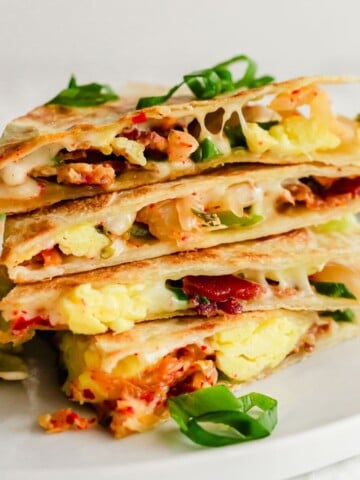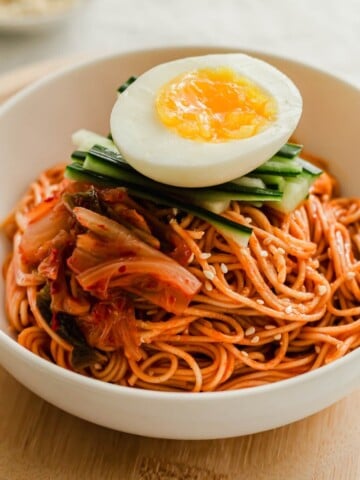Tteokbokki is a delicious and comforting dish of Korean rice cakes smothered in a sweet and savory, spicy gochujang sauce.

Want to save this recipe?
Enter your email & I'll send it to your inbox. Plus, get great new recipes from me every week!
What is tteokbokki?
Tteok refers to rice cake in Korean, and bokki means "stirred."
(It's a little bit of a misnomer, since the rice cakes are not technically stir-fried, but rather simmered).
Spicy Korean rice cakes or tteokbokki (also spelled as ddeokbokki, ddukbokki, dukbokki, topokki) is a popular Korean street food dish of cylindrical rice cakes simmered in a sauce.
The sauce can either be red gochujang, which is most common, or a soy-based sauce (known as ganjang/gungjung tteokbokki).
Traditionally, fish cakes, boiled egg and scallions/green onions are in tteokbokki.
Variations can include cabbage, mandu (dumplings), cheese and ramen noodles, which are added to make a heartier one-pot stew, similar to Buddae Jiggae.
What does it taste like?
Korean spicy rice cakes have a chewy, bouncy texture similar to mochi, and a deep savory depth of flavor from the anchovy broth and gochujang.
What are Korean rice cakes?
Korean rice cakes are made from rice flour (non-glutinous).
They can come in different forms, ranging from flat oval discs to cylindrical rods.
For this dish, we're using short, cylindrical rods.
They are unflavored and have a chewy, bouncy texture.

What is gochujang?
Gochujang is a fermented Korean red pepper paste, made with red chili peppers, fermented soybeans, glutinous rice flour, barley and salt.
It has a predominantly savory flavour, and depending on how much chili is in it, can be a little spicy.
You can find gochujang in Korean supermarkets, or large grocery stores, usually in packaged plastic tubs.
Why you'll love this dish
Tteokbokki is really simple to prepare.
Although not traditional, this version contains minced garlic and shallot to give the sauce even more flavour.
It's a great recipe to use up any leftover dashi stock/anchovy broth.
Spicy rice cakes are a delicious snack, appetizer, or even a meal.
The chewy rice cakes soak up all that delicious sauce, making it a comforting and homey dish.
Ingredients you'll need
- Korean rice cakes: preferably cylindrical in shape; they may come as long rods, which you can cut to size; you can find them in the refrigerated section near fresh noodles, or in the freezer section
- vegetable oil: any neutral oil will work; for sautéing the aromatics
- garlic: minced
- shallot: minced
- gochujang: Korean red chili pepper paste; you can find it in small tubs in Korean grocery stores
- gochugaru: Korean chili powder or Korean chili flakes, depending on how fine the red chili has been ground; also available in packages in Korean grocery stores; you can substitute with regular chili powder or paprika
- maple syrup: or other sweetener, such as granulated sugar, honey
- anchovy stock/dashi broth: you can also use kelp broth, vegetable stock or water -- if using water, add a little soy sauce for seasoning
Garnish
- sesame oil
- green onions/scallions
- sesame seeds
Optional additions
- fish cake (eomuk): thinly sliced
- boiled eggs; you could even use Korean marinated eggs
- spam: sliced; or any other ham
You can find all these ingredients at Korean grocery stores or Asian supermarkets.
How to make spicy Korean rice cakes
In a bowl, combine gochujang, gochugaru (Korean chili powder), maple syrup (or other sweetener), anchovy broth and give it a stir. Set aside.
Heat up vegetable oil in a frying pan or large skillet over medium heat.
Add minced garlic and shallot and sauté until aromatic and slightly softened.
Add in the rice cakes and pour in the gochujang-anchovy broth mixture.
Give it a stir and let it simmer uncovered, until the sauce thickens and the rice cakes swell, about 5 minutes.
Remove from heat, garnish with green onions/scallions, sesame seeds and a drizzle of sesame oil.
Serve immediately.
How to serve
Enjoy the spicy Korean rice cakes freshly cooked, while hot.
Once it cools, the rice cakes will harden.
If serving as a snack/street food-style, you can place some rice cakes in a small container along with the tteokbokki sauce and enjoy with toothpicks.
How to store & reheat leftovers
Store any leftover tteokbokki in an airtight container in the refrigerator for up to 3 days.
To reheat, place the tteokbokki in a microwave-safe bowl with a splash of water.
Cover with a lid and heat for 1-2 minutes, or until steaming hot. The rice cakes should be soft once again.
FAQs
Can I make it vegan?
For a vegan tteokbokki, substitute the anchovy broth with vegetable broth, or use water.
Can I make a larger batch?
Yes, you can double up the recipe to make a larger batch.
Need more flavor?
Add in a little soy sauce or Korean doenjang (soybean paste) to the gochujang mixture for extra umami.
Can I make it less spicy?
You can reduce the amount of gochujang (Korean red pepper paste) or gochugaru (Korean chili powder) if you want it less spicy.
Why did the rice cake get hard after cooking?
The rice cakes should be served while hot. Once cooled, the rice cake will harden.
Also, don't over simmer the sauce. If the sauce becomes too thick, the rice cakes will not retain enough moisture and become hard.
You can add the rice cakes to a small bowl and add 1-2 tablespoon of water. Cover with a lid and microwave for 1 minute to steam the rice cakes until softened.
How to make tteokbokki into a meal?
Feel free to other additions such as fish cakes, kimchi, napa cabbage, boiled egg, spam, dumplings (mandu) to make the tteokbokki into a hearty, filling meal.
Other Korean recipes you may like
Be sure to check out these recipes:
Spicy Gochujang Eggs in Purgatory
Budae Jiggae (Korean Army Stew)
Pillowy Soft Korean Sausage Bread
Korean Loaded Fries With Bulgogi Beef & Kimchi
Mayak Eggs (Korean-Style Marinated Eggs)
Easy Korean Beef Tacos (Instant Pot)
Quick and Easy Kimchi Grilled Cheese
Let me know if you try out this recipe -- tag me on Instagram @siftandsimmer or leave me a comment/rating below!

Tteokbokki (Korean Rice Cakes in Gochujang Sauce)
For accuracy and precision in baking recipes, use weight (metric) measurements when available.
Ingredients
- 1 tablespoon gochujang (Korean red pepper paste) or to your taste, depending on how spicy you like it
- 2 teaspoon gochugaru (Korean chili powder) or to taste
- 1 tablespoon maple syrup or other sweetner
- 1 ½ C anchovy broth
- 1 tablespoon vegetable oil
- 1 clove garlic minced
- 1 medium shallot minced
- ½ lb Korean rice cakes (cylindrical) rinsed and soaked in water for 10 minutes
Garnish:
- green onions/scallions
- sesame seeds
- sesame oil
Instructions
- In a bowl, combine gochujang, gochugaru (Korean chili powder), maple syrup (or other sweetener), anchovy broth and give it a stir. Set aside.
- Heat up vegetable oil in a frying pan or large skillet over medium heat.
- Add in minced garlic and shallot and sauté until aromatic and slightly softened.
- Add in the rice cakes and pour in the gochujang-anchovy broth mixture.
- Give it a stir and let it simmer uncovered, until the sauce thickens and the rice cakes swell, about 5 minutes.
- Remove from heat, garnish with green onions/scallions, sesame seeds and a drizzle of sesame oil. Serve immediately.
Nutrition
The nutritional information provided should be considered as approximate and is not guaranteed. Please use your best judgment to ensure food is safely prepared and/or a good fit for your diet.








Heidi | The Frugal Girls
Your homemade gochujang sauce adds so much fabulous flavor to this dish. I also loved your ideas for topping this with some protein!
Ben | Havocinthekitchen
I've never heard of these Korean rice cakes, but the dish looks tasty and sounds intriguing. I like the texture of Mochi, so this is something I should also like!